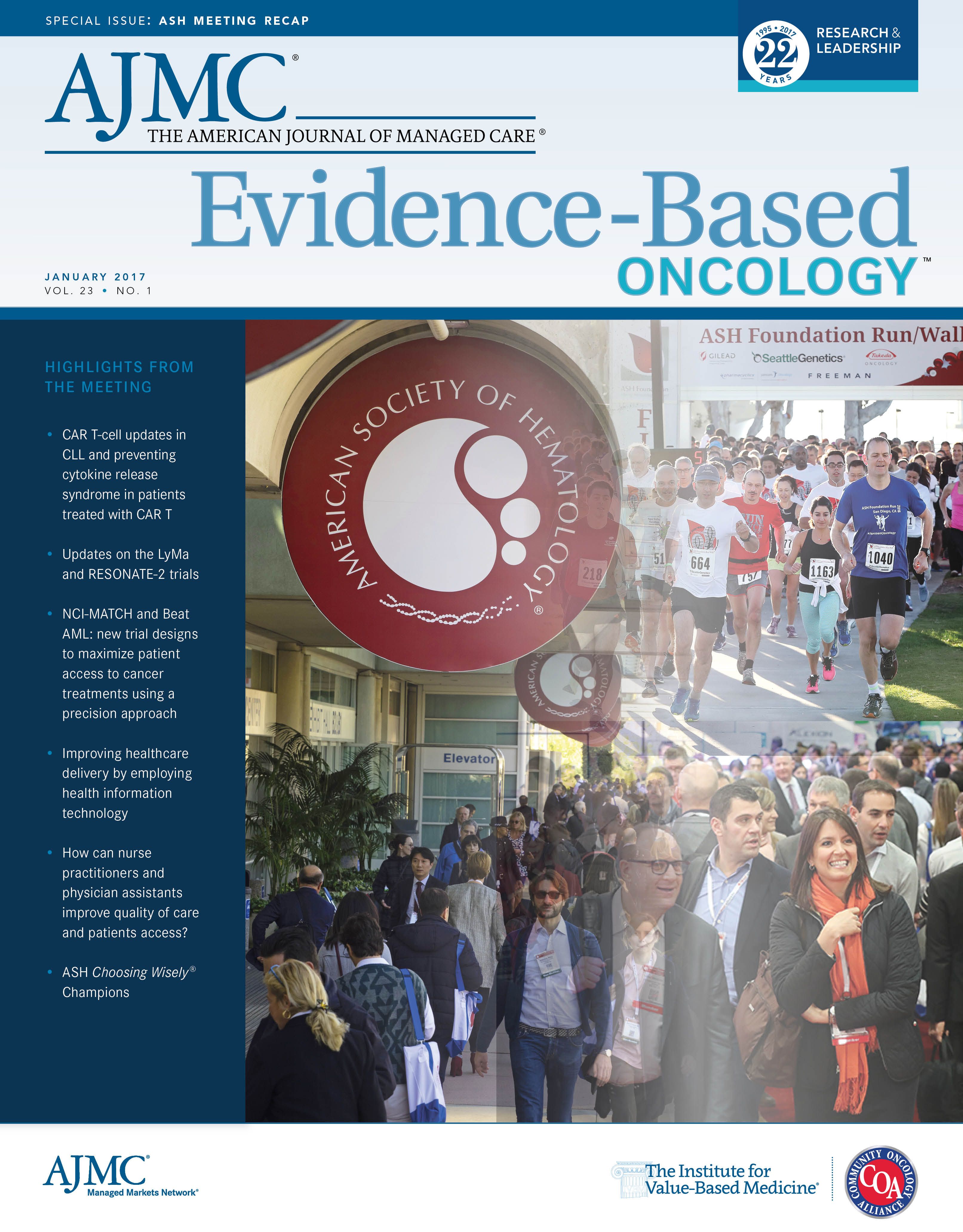Publication
Article
Evidence-Based Oncology
RESONATE-2 Continues to Impress With Single-Agent Ibrutinib for CLL/SLL at 29 Months
Author(s):
Despite the complexities associated with treating older patients diagnosed with chronic lymphocytic leukemia (CLL) and small lymphocytic lymphoma (SLL), patients in the RESONATE-2 trial continue to present a favorable response to single-agent ibrutinib at a follow-up of 29 months.
DESPITE THE COMPLEXITIES ASSOCIATED
with treating older patients diagnosed with chronic lymphocytic leukemia (CLL) and small lymphocytic lymphoma (SLL), patients on the RESONATE-2 trial continue to present a favorable response to single-agent ibrutinib at a follow-up of 29 months. Paul Barr, MD, assistant professor of medicine, University of Rochester, Wilmot Cancer Institute, Rochester, New York, presented these results at the 58th American Society of Hematology Annual Meeting & Exposition, held December 3-6, in San Diego, California.
Barr told the audience that CLL/SLL are very common in older patients, who often have increased comorbidities and cannot tolerate aggressive treatments, which leads to poorer outcomes. Alkylating agents, such as chlorambucil, are a very common treatment option in this patient population. Ibrutinib is a Bruton’s tyrosine kinase inhibitor, which was approved by the FDA in early 2016 as first-line treatment for CLL in patients who cannot tolerate strong treatment.1 The approval was based on a little more than 18 months of follow-up of ibrutinib treatment; the current results are a 29-month follow-up.
Presenting the study design to the audience, Barr showed that 269 treatment-naïve patients diagnosed with CLL/SLL, who were at least 65 years old, were randomized 1:1 to either the chlorambucil or the ibrutinib arm. Patients with a 17p deletion were excluded from the study. Patients received 420 mg ibrutinib once daily until progression or chlorambucil 0.5 mg/kg on days 1 and 15 of a 28-day cycle, for up to 12 cycles. Patients continued on the study until study closure or disease progression. “Fifty-five patients on the chlorambucil arm were crossed over to the ibrutinib arm due to disease progression,” Barr said.
The primary trial endpoint was progression-free survival (PFS); secondary endpoints included overall survival (OS), objective response rate, rate of hematologic improvement, and safety.2
Barr showed that ibrutinib prolonged PFS over chlorambucil, with an 88% reduction in risk of progression or death for patients randomized to ibrutinib. The 24-month PFS was 89% in the ibrutinib arm compared with 34% in the chlorambucil arm (P <.0001). PFS was significantly improved for ibrutinib across high-risk subgroups, including del11q and the unmutated IGHV gene, Barr showed.
“Ibrutinib continues to demonstrate OS benefit over chlorambucil,” Barr said. The 24-month OS was 95% in the ibrutinib arm compared with 84% in the chlorambucil arm. “Complete response (CR) to ibrutinib continues to improve over time, increasing from 7% at 12 months to 15% at 24 months. At a median follow-up of 29 months, the CR rate is at 18%,” Barr added.
Sustained improvements in hematological functions of patients were observed and were higher for ibrutinib compared with chlorambucil. In patients with anemia, hemoglobin levels were 90% versus 45%
(P<.0001), ibrutinib versus chlorambucil, respectively. In patients with thrombocytopenia, platelet counts were at 80% versus 46% (P = .0055), ibrutinib versus chlorambucil, respectively.
“Ibrutinib is a good option because most patients remain on ibrutinib therapy at 29 months,” Barr told the audience. He showed that 79% of patients have remained on ibrutinib, and 83% of participants continued on treatment for at least 2 years. Of the 21% patients who discontinued the drug:
- 3% had disease progression
- 12% had adverse events (AEs)
- 4% died
- 1% withdrew consent
In terms of AEs, atrial fibrillation was slightly higher (10%) than other studies, which could be because of the higher average age of this cohort, Barr explained. Of the 16 patients who discontinued ibrutinib treatment due to AEs, 13 remain alive after 13 months of follow-up. Some of the other AEs observed in the ibrutinib-treated arm included major hemorrhage, diarrhea, and anemia.
Ibrutinib is definitely more effective than chlorambucil in the high-risk patient population (del11q and unmutated IGHV), Barr said. “The quality of responses in patients with CLL/SLL being treated with single-agent ibrutinib continues to improve with time,” Barr concluded. “Further, rates of treatment-limiting AEs decreased over time, and a majority of the elderly patient population in the trial remains on daily ibrutinib.”
REFERENCES
- Dangi-Garimella S. Phase 3 RESONATE-2 data yield first-line approval for ibrutinib in CLL. The American Journal of Managed Care® website. http://www.ajmc.com/newsroom/phase-3-resonate-2-data-yields-first-line-approval-foribrutinib-in-cll. Published March 4, 2016. Accessed December 4, 2016.
- Barr PM, Robak T, Owen CJ, et al. Updated efficacy and safety from the phase 3 RESONATE-2 study: ibrutinib as firstline treatment option in patients 65 years and older with chronic lymphocytic leukemia/small lymphocytic leukemia. Presented at: 58th American Society of Hematology Annual Meeting & Exposition; December 3, 2016; San Diego, CA. Abstract 234.





